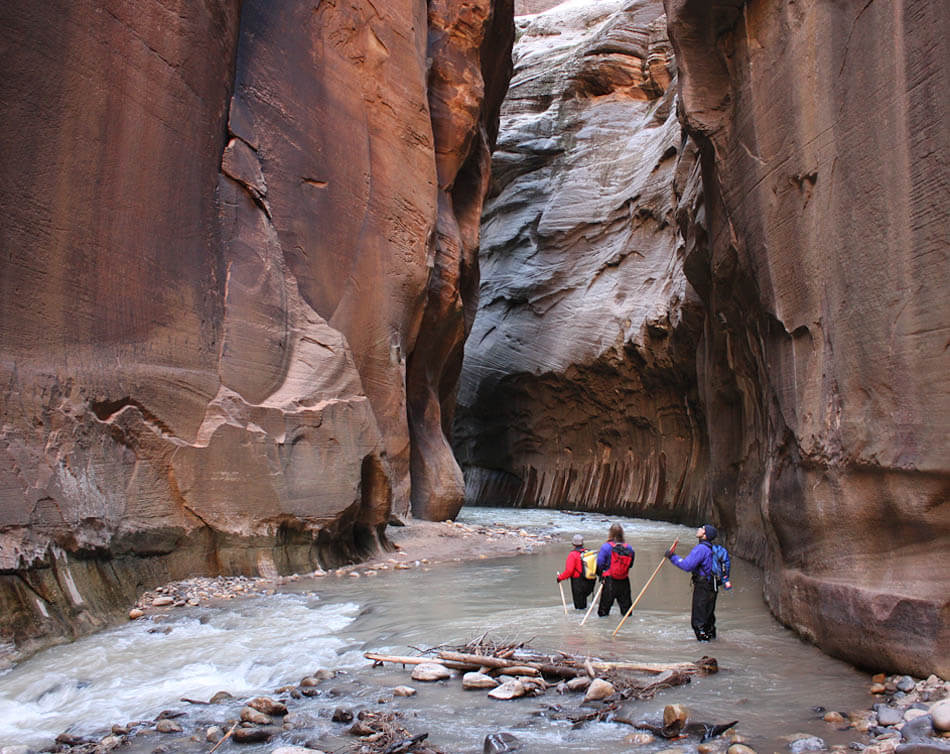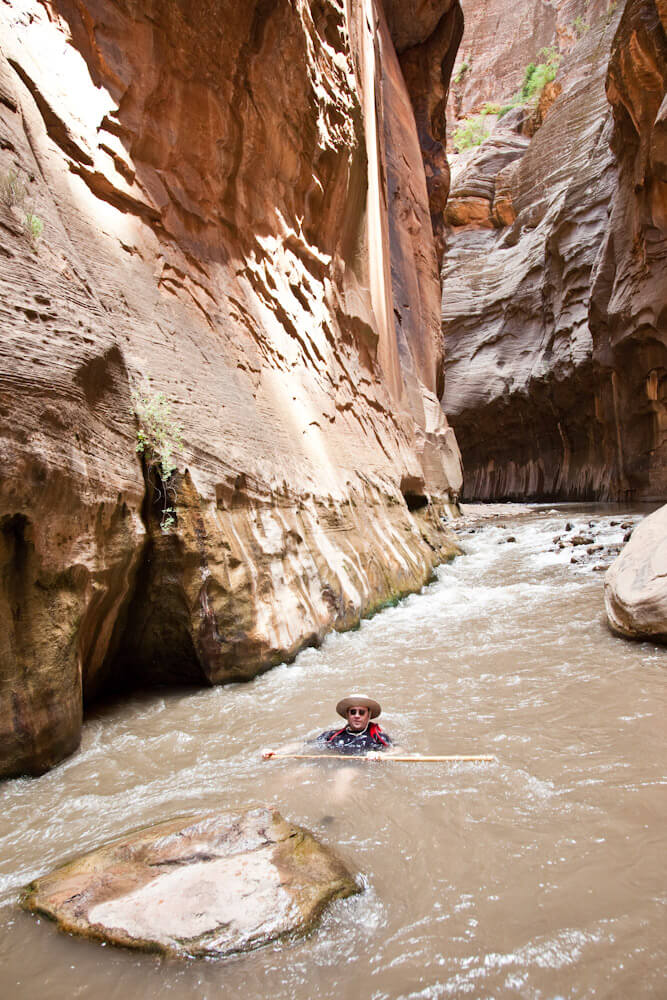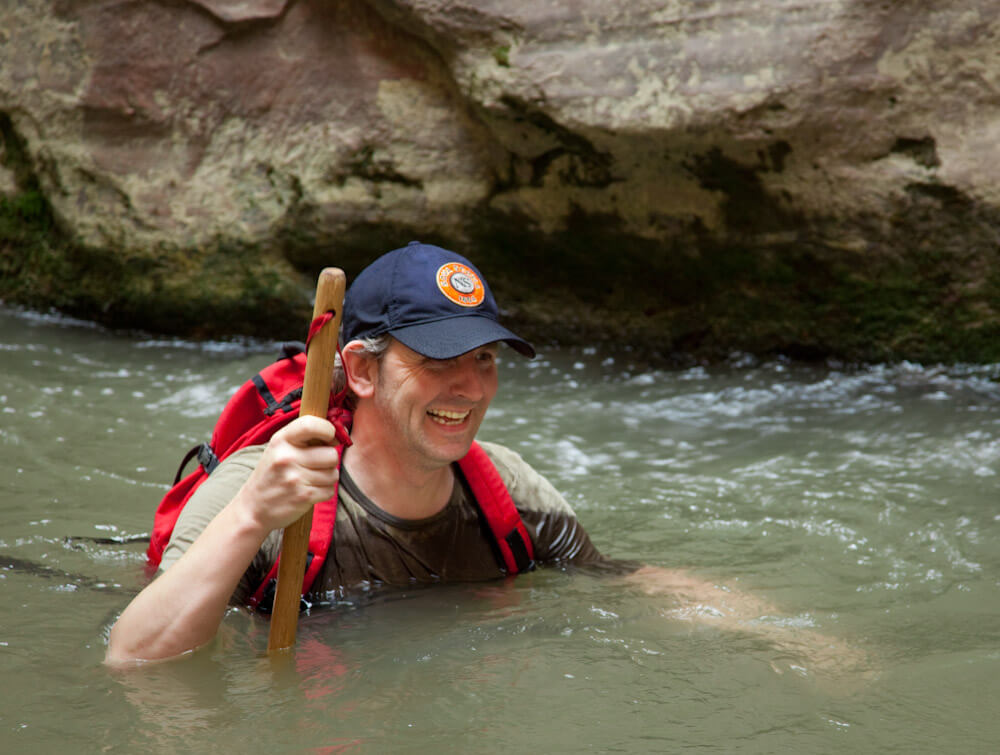an incredible experience.
The indians call the canyon through which it runs "Mu-koon'-tu-weap" or Straight Canyon. Entering this, we have to wade upstream; often the water fills the entire channel, and although we travel many miles, we find no flood plain, talus, or broken piles of rock at the foot of the cliff. The walls have smooth, plain faces and are everywhere very regular and vertical for a thousand feet or more, where they seem to break back in shelving slopes to higher altitudes; and everywhere as we go along we find springs bursting out at the foot of the walls, and, passing these, the river above becomes steadily smaller; the great body of water, which runs below, bursts out from beneath this great bed of red sandstone; as we go up the canyon, it comes to be but a creek, and then a brook.
- John Wesley Powell, describing the Zion Narrows hike, 1872.
The Zion Narrows hike
The Narrows, or more formally, the narrows of the North Fork of the Virgin River, has become one of the most famous hikes in the world, and for good reason. It is Zion's hallmark hike. For beginner and intermediate hikers, it can be quite a challenging adventure. Fit, experienced hikers will be wowed by the soaring sandstone walls and the novelty of walking IN the river for miles at a time. Whether done as an overnight through-hike, from the top down as a dayhike, or from the bottom up, the Zion Narrows hike is a classic not to be missed. Photo credit: Nick Wilkes
hike Profile
For experienced backpackers, doing the Zion Narrows hike in its entirety makes for a very nice one-night backpack trip. Most times of year, you won't even need a tent! Since you are staying overnight in the canyon, the weather forecast must be stable, with no chance of storms/flooding. Overnight permits can be hard to get on holiday and summer weekends, so act early. Car spot or shuttle required to Chamberlains Ranch.
One-Day Through-Hike from the Top
16 miles of difficult hiking in one day? Feels like 26 miles. For the athletic, this is a reasonable option and makes for a fine adventure and a great introduction to Zion. If possible, however, take another day to enjoy this memorable hike, giving you time for taking photos, exploring side-canyons, romping in swimming holes, and lounging in camp. Car spot or shuttle required to Chamberlains Ranch.
The most popular option, due to its simplicity and moderate physical commitment. Hike up the river as far as Big Springs, then turn around and return the way you came. Visit Orderville Canyon too, if you have the time. Makes a wonderful half-day or full-day hike with easy logistics. Good in the winter, when a through-hike is not practical. Day hiking from the bottom does not require a permit.
Seasonal Adjustments
HIGH SUMMER: MAY 15 - SEPTEMBER 15
High summer is the best time to through-hike the Narrows. Zion National Park can be downright sweltering in the summer months, so escaping into the deep, twisty and cool river gorge makes for a delightful escape from the heat. Water levels are generally low, and only a spot or two of deep wading or swimming is required. First of June, the water is cold, but as the summer progresses the water becomes warmer and warmer.
High summer is, however, thunderstorm season in the desert southwest. The Monsoon pattern can set up anytime during high summer, making the Zion Narrows hike dodgy at best. This is a good time to explore the Narrows from the bottom up, starting early in the morning, and keeping a careful eye on the sky. The weather forecast and flashflood warning level is posted early each morning at the Visitor Center – be sure to check it before heading out.
Even without the Monsoon, the Narrows should be hiked with a keen eye on the sky to the north. Thunderstorms occur largely in the late afternoon, so get up early and put those miles in before mid-afternoon, so you will be in a safe place during those critical hours 3:00 PM to 10:00 PM. The North Fork watershed comprises 400 square miles of terrain mostly north of The Narrows. Hard rain in any part of this watershed can cause flooding, sometimes with several hours of delay.
The top half of the Zion Narrows hike can be hot and sunny, especially in July and August. Get an early start, be prepared for heat, and bring sunscreen.
AUTUMN: SEPTEMBER 15 - NOVEMBER 1
Fall is lovely in Zion, and The Narrows is at its most spectacular. The slanting light can be amazing, and the colorful leaves complement the colorful walls. Fabulous.
The water level tends to be very low, and hiking in the river is at its easiest. Air and water temperatures are lower and care must be taken to be properly attired to avoid a chill. The days are shorter, early starts more difficult.
WINTER: NOVEMBER 1 - MARCH 15
Winter is a great time to visit the Zion Narrows, though specialized equipment is required to stay warm. With few visitors in the lower reaches, hiking up from the bottom has a wilderness feel to it lost in the summer crowds. A dry suit and thick neoprene socks can make hiking a very reasonable proposition – equipment can be rented in Springdale.
A through-hike in the winter is difficult. The road to Chamberlain ranch is often closed in the winter, even to 4WD vehicles. The water is frigid, requiring dry suits and thick neoprene socks from the start. If the sun is out and snow is melting in the high country, the river level can rise rapidly. Ice falling off the walls can also be a hazard.
SPRING: MARCH 15 - MAY 15
Spring is a great time to visit Zion, but not The Narrows. The Virgin River is high and cold, fed by melting snow in the headwaters to the north. River levels are unpredictable – a lot depends on the upper level snowpack, and when and where the sun comes out. March and April are also the rainiest months in Utah. Toward the end of May, Zion changes over to summer conditions. Though the water is chilly, if the snow has melted out, the river gets down to a reasonable level and the hike is great.
Flash Floods
Flash Floods can occur any time heavy rain drops in the extensive drainage area of the North Fork. The river can rise from the normal 18" (1/2 m) deep to 6 feet (2 m) in a matter of minutes. Travel in the river is impossible during flood.
So what's a person to do?
Many people have survived flashes of the Zion Narrows by going to high ground at the first sign of flood and staying there until it was over. "High Ground" means places more than 6 feet above water level, and preferably with mature trees. "Staying There" means waiting 24 hours for the flood cycle to complete. All of the designated campsites are in the Upper Narrows, where high ground is easily accessed. There are only occasional escapes to high ground in the Lower Narrows, below Big Spring.
If you have any doubt, WAIT. Wait, wait, and wait. You will not drown while waiting. You cannot out-run, out-swim, or out-hike flood waters. Stay put. You won't starve in 24 hours. Do NOT expect a rescue. If you cannot get out, rescue teams cannot get in to help. Plan on taking care of yourself.
It does not have to be raining where you are for the canyon to flash. The headwaters of The Narrows lie 20 miles north, so a strong storm there can easily flood the river several hours AFTER the rain falls.
What are signs of a coming flood? Any changes in water flow or characteristics, such as even a slight increase in flow, a change to murky, silt-laden water, a roaring sound from up-canyon, or a rapid increase in leaves and twigs on the water indicate that a flood is likely. Flash floods tend to build – they start with a modest increase in flow. A few minutes later, another increase in volume, and so on, until the gentle river has become a raging maelstrom. Don't get caught.
At the first sign, the wise hiker will find high ground to safely wait out the flood. Those who try to out-run the flood usually fail.
permits
Permits are required for all through-hikes, including overnight trips, of The Narrows. Zion National Park visitors may obtain Zion Narrows hike permits at the Visitor Center near Springdale, or the Kolob Canyons VC near Cedar City. The 80-person per day limit is often reached on holiday weekends in the summer. Campsites are assigned for overnight visitors, and there are a limited number of sites.
Hiking from the bottom and then camping is not permitted. Hikers from the bottom are not supposed to go above Big Springs – and really, there is no real good reason to do so, as extra time is better spent enjoying Orderville Canyon.
Permits for the Zion Narrows hike are only issued the day before the start of your hike. Reservations most likely can be made – check the backcountry info at www.nps.gov/zion or call the Backcountry Desk for the current procedure.
Just because you have a permit, it does not mean it's safe to hike the Zion Narrows. Zion National Park rangers will close the through-hike when conditions are obviously unsafe, but there is a lot of gray area.During spring snowmelt, when the river is high, The Narrows will be closed – usually for not more than 30 days in April and May, but in big snow years sometimes as late as July 15th. In the summer, a National Weather Service Flash Flood Warning will close The Narrows when thunderstorms are dumping rain into The Narrows, or into the headwaters 20 miles north of the park... but, the Park does not "gate" The Narrows closed. During cold weather in the winter, obtaining a permit may require quite a bit of assurance on your part that you are well-equipped and know what you are doing. Being issued a Zion Narrows permit does not mean the Zion Narrows hike is safe. The Park Service is not responsible for your safety – You are.
clothing & equipment
Poles – A hiking staff or hiking poles are invaluable for maintaining balance while hiking in the river. Downhill ski poles work fine, but they take a beating and sometimes snap.
Footwear – Imagine walking through knee-deep murky water with a bunch of roughed-up bowling balls hidden in the murk. This is what hiking The Narrows is like, and sandals, even Tevas or Keenes, do not provide protection for the feet. Specialized water shoes such as Five.Ten Canyoneers and La Sportiva Exum Rivers are by far the best, but any sturdy sneaker or light hiking boot that is made from 100% synthetic materials will work fine. Neoprene socks or synthetic hiking socks work well.Neoprene socks provide warmth and padding, AND keep fine sand away from your feet. Canyoneers and Exum Rivers can be rented in Springdale.
Shorts – Long pants are never in fashion in The Narrows. Zion shops offer myriad options for quick-drying, synthetic hiking shorts; get some and you will be happy. Any trip through The Narrows is likely to include wading to at least waist deep and your shorts will get wet.
Shirts and Sweaters - Some people find the classic cotton t-shirt works well in the middle of the summer, but most times of the year, hikers will enjoy a quick-drying, lightweight synthetic top such as those made from Patagonia's Capilene. All hikers should bring a synthetic sweater to ward off the chill. Even in the hottest weather, it is cool and damp the Zion Narrows hike and a bit of warmth can be very welcome. Through hikers will want to carry a warm hat.
Keeping Stuff Dry – Anything valuable – wallet, camera, car keys – ought to be fully protected from immersion, as even the most nimble hiker can trip and fall into the river at any time. Those with a river-running background will have drybags or Dry Kegs to use, or these can be purchased for about $25.00 at many outdoor stores, including those in Springdale. The frugal hiker can make do with large plastic bags – use the thicker, trash-compactor bags – double sealed. When using plastic bags, it is important to get everything INSIDE the pack – plastic bags on the outside quickly spring leaks.
Pack Light – For all Narrows trips, keep the pack as light as possible. The rugged terrain and in-stream hiking exact a toll on the over-burdened. A tent is not necessary, nor is excess camping gear like camp chairs. There are a few campsites that have a few mosquitoes – bring a bit of repellant, rather than a tent. A pair of cheap flip-flops are nice for loafing around camp and letting your shoes dry out.
Winter Wear – In winter, a dry suit and thick neoprene socks are a necessity. These can be rented in Springdale, but call ahead as outfitters may not keep regular hours in the off-season.
HYGIENE
Poo - The Narrows is a heavily-used camping area, and thus has a fecal impact problem. The river corridor is narrow and after the first two miles, provides no ecologically sound place to leave your crap. The Backcountry Desk will supply you with a "Restop" system for capturing and carrying out your poop, and these work surprisingly well. A gel inside the bag absorbs all moisture, and chemicals significantly reduce the odor. These work great – use them!
Pee - Whenever possible, pee directly into the flowing water of the river. The smell of your urine, on land, will persist for months.
At the very least, carry a ziplock bag to pack out your toilet paper.
Water – There is reasonable water for drinking almost every step of The Narrows – literally. However, the water in the North Fork is often silty and clogs filters rapidly. North Fork water itself is contaminated from cows grazing above, and from the less-socially-conscious hikers that preceded you. From place to place, there are better places to get water including: Deep Creek, Goose Creek and Big Springs. Below Big Springs, there are many small springs to the side that provide silt-free water. All water should be filtered or treated before drinking. Use a coffee pre-filter to keep your pump from clogging. Watch out for poison ivy at Big Springs.














